This avocado sushi recipe isn't just for vegetarians or people who don't like eating raw fish. Why not try out this fun, refreshing recipe this summer. It's much easier to make than it looks. And it requires no special Japanese cooking tools, unless you own a butane torch! (optional fun)
Jump to Recipe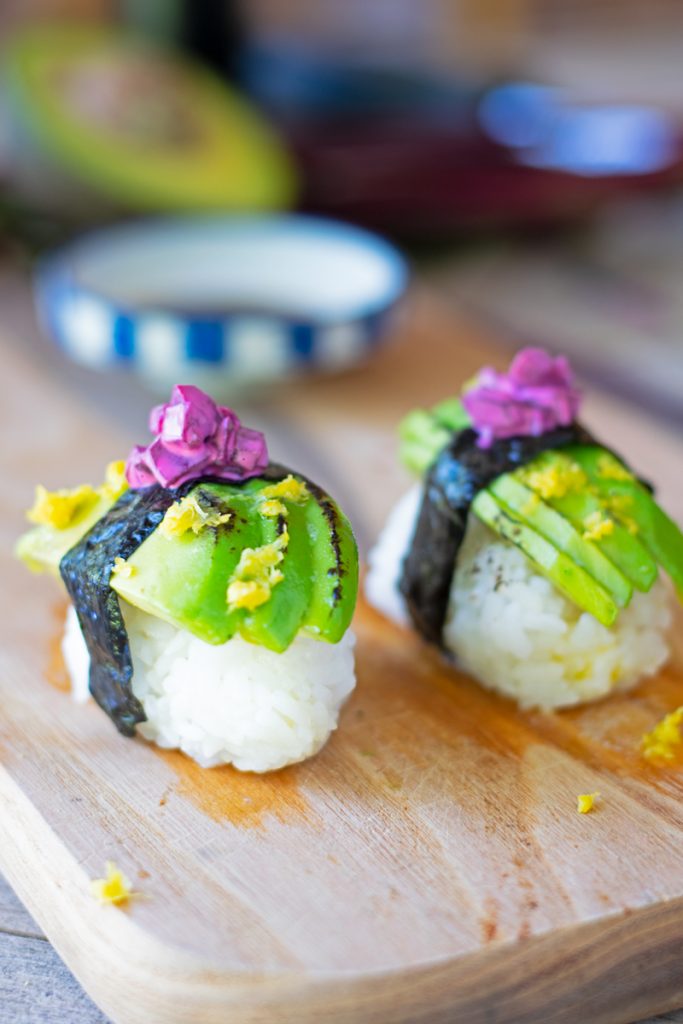
What is avocado sushi? (アボカド寿司? 何それ?)
I discovered a common misconception.
Most people outside of Japan, including for former self, assume that sushi means "raw fish".
To be honest, I always thought of avocado sushi as some sort of imitation sushi.
That's not 100% true. No, avocado sushi is definitely not traditional or authentic sushi from Japan. Though, it can still be considered sushi.
Here's why.
Sushi (寿司) in Japanese, means "sour rice". The name refers to the vinegar-seasoned rice, which can be topped with a variety of ingredients, including raw fish, other seafood, or vegetables(*).
Su = vinegar, in Japanese
Shi (as in the ‘shi’ in meishi) = rice
Avocado sushi is slices of ripe avocado that’s served on top of balls of sushi rice or wrapped with nori seaweed as a roll.
*Though, if you really want to get technical, you can make the argument that avocado is a fruit, not a vegetable.
What is vegan sushi?
Nowadays, "vegan sushi" is becoming popular outside of Japan since around 2016.
Rightfully so, people are more concerned about sustainability, overfishing, mercury levels in ocean fish, and plastic contamination in sushi.
Vegan sushi replaces all the raw seafood with plant-based ingredients, such as avocado.
Vegan or vegetarian sushi often imitates the taste and texture of real seafood ingredients. However, I doubt that is the case with avocado sushi.
Avocado was first introduced as a sushi ingredient in California rolls, not in Japan, which were actually invented in Canada.
In Japan, vegan sushi might still be considered by many to be a bizarre foreign misinterpretation of Japanese food.
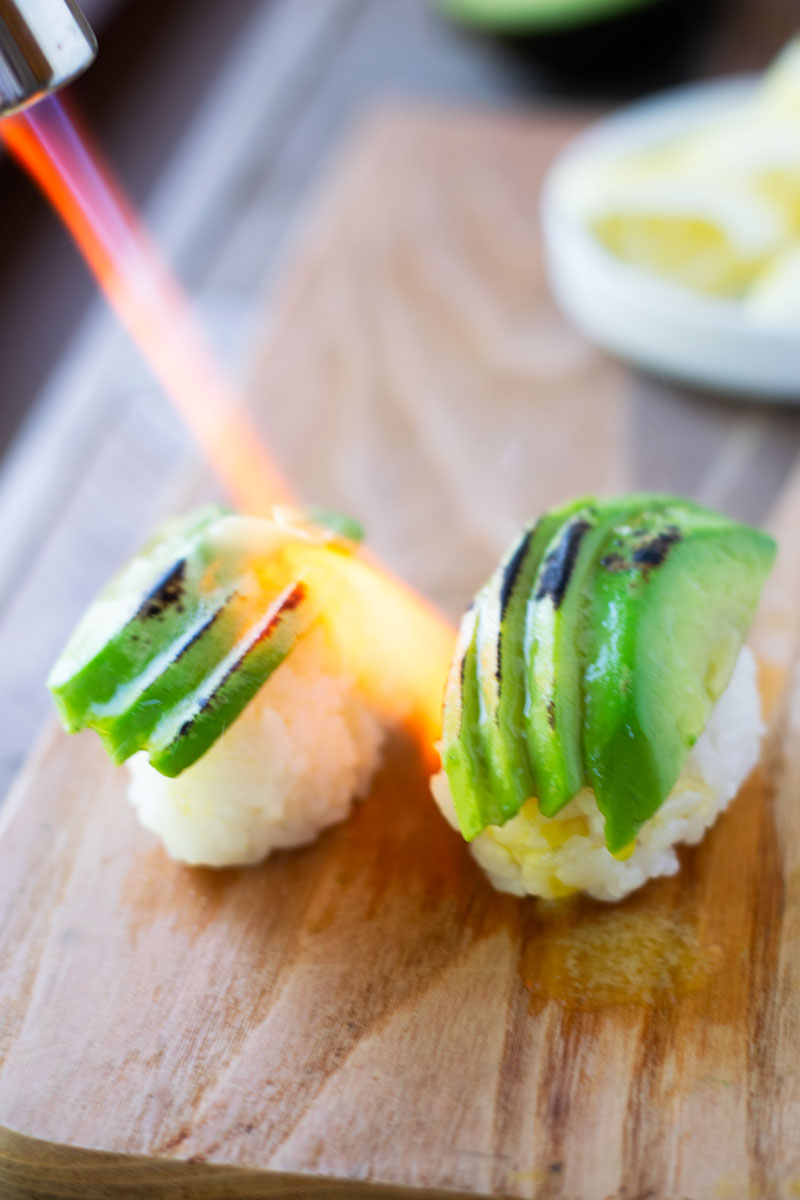
Avocado Sushi (Nigiri vs. Sushi Roll)
There are two basic types of avocado sushi:
- nigiri-zushi
- sushi rolls (maki-zushi)
Note: Zushi means the same thing as sushi. The s- just gets changed to a z- sound to make the compound word easier to pronounce.
Avocado Nigiri-Zushi
My recipe is for avocado nigiri.
Avocado nigiri sushi (pronounced nigiri-zushi) is a small, oblong ball of vinegared sushi rice topped with slices of avocado as a neta (ネタ).
In Japan, neta is typically a single, bite-sized piece of raw fish or other seafood that goes on top of the ball of sushi rice. Sometimes it’s cooked, flame-broiled, cured, pickled, or boiled.
Nigiri-zushi is what you would typically order at a sushi restaurant (sushi-ya) in Japan.
From my experience at restaurants, nigiri are usually ordered first.
Sushi rolls tend to be ordered towards the end of a meal because the rice fills you up.
Avocado Sushi Rolls (Maki-Zushi)
The other version of avocado sushi, that's much more common in the U.S., is an avocado roll.
In Japanese, sushi rolls are called "maki-zushi", "norimaki", or collectively "makimono".
An avocado roll is a seaweed wrap made with strips of ripe avocado, sushi rice, and a sheet of nori dried seaweed.
It's rolled into a long cylinder-shaped roll with a bamboo mat called makisu (巻き簾) and sliced into bite-sized pieces.
Note: Avocado can also be used as ingredient to make hand rolls temaki-zushi, which are very easy to make. Here's my recipe for temaki-zushi.
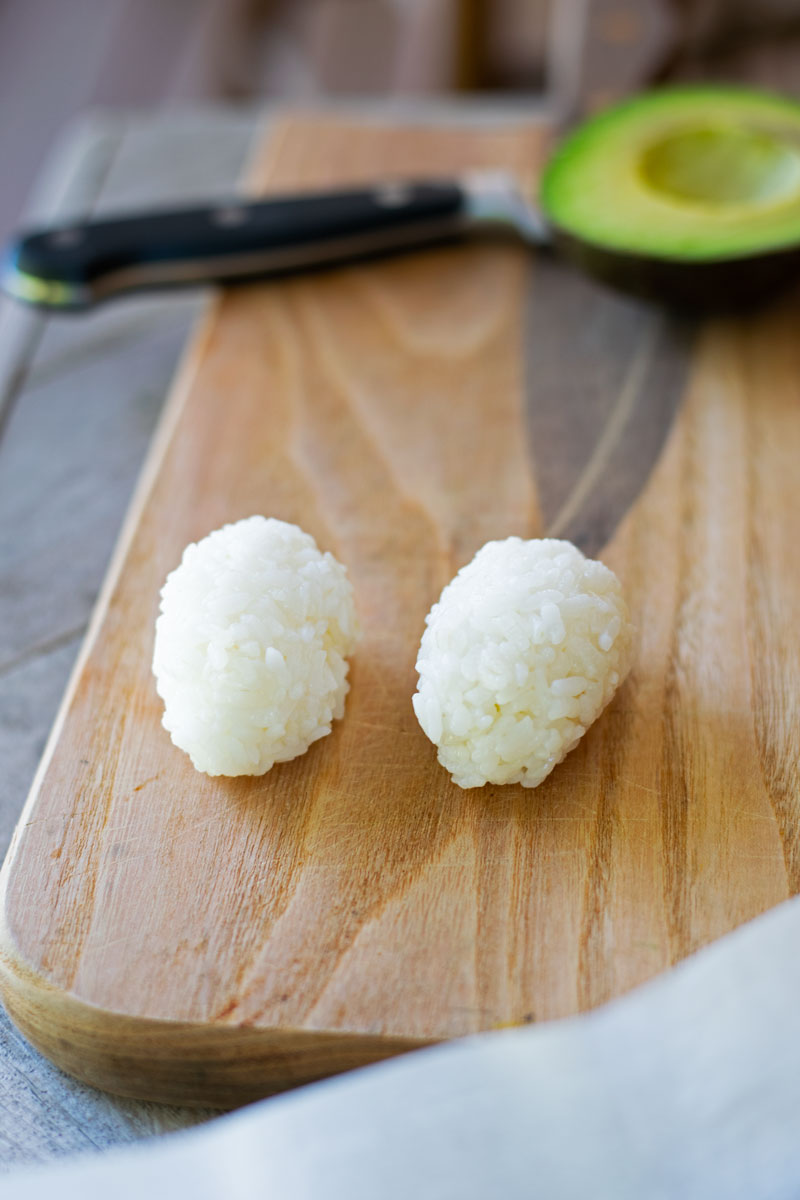
Is avocado sushi healthy?
Avocado
Yes! Avocado sushi is good for you!
The exception is if it's lathered in sauces that are high in sugar, mayonnaise, or it's battered and deep-fried.
And there is such thing as too much of a good thing, whether that's going overboard on avocado or white rice.
Avocados are a superfood. They're a very nutrient-dense food.
They’re very high in potassium and fiber.
Avocados are also high in healthy fats, mostly mono-saturated .
Organic avocados vs. Non-organic
Since avocados are on EWG's "Clean 15" List in 2022, I usually don't buy organic avocados.
Sushi rice (white rice vs. brown rice)
Whether to eat white rice or brown rice is a debated topic in nutrition circles.
White rice contains fewer vitamins and minerals than brown rice.
It's higher in empty carbs and doesn't contain a lot of nutrition.
The downside of brown rice is that it contains anti-nutrients and higher levels of arsenic.
I eat white rice it in moderation and minimize the amount of sushi rice I use, compared to what's served at a sushi restaurant.
Organic white rice vs. non-organic white rice
I do recommend choosing organic rice, if you can afford it.
High amounts of pesticide residue can be found on rice.
Because I eat very limited amounts of white rice, I don't worry about it too much.
Avocado sushi calories
Both avocado and sushi rice are not low calorie foods.
One piece of this avocado sushi contains approximately 130 - 140 calories.
Here is the breakdown of ingredients:
¼ avocado = 80 calories
¼ cup of white rice (cooked)= 50 calories
vinegar= 3 calories
sugar= 4 calories
salt= 0 calories
To reduce the number of carbs and calories in avocado sushi, cauliflower rice can be substituted for white rice, in theory. I haven't tried it yet.
Most would agree, white rice is more satisfying than cauliflower rice. But if you are strictly following a keto or low carb diet, cauliflower rice is an option. It just won't fill you up and may be challenging to get the cauliflower rice to stick together properly.
Brown rice can also be substituted but it contains more calories than white rice.
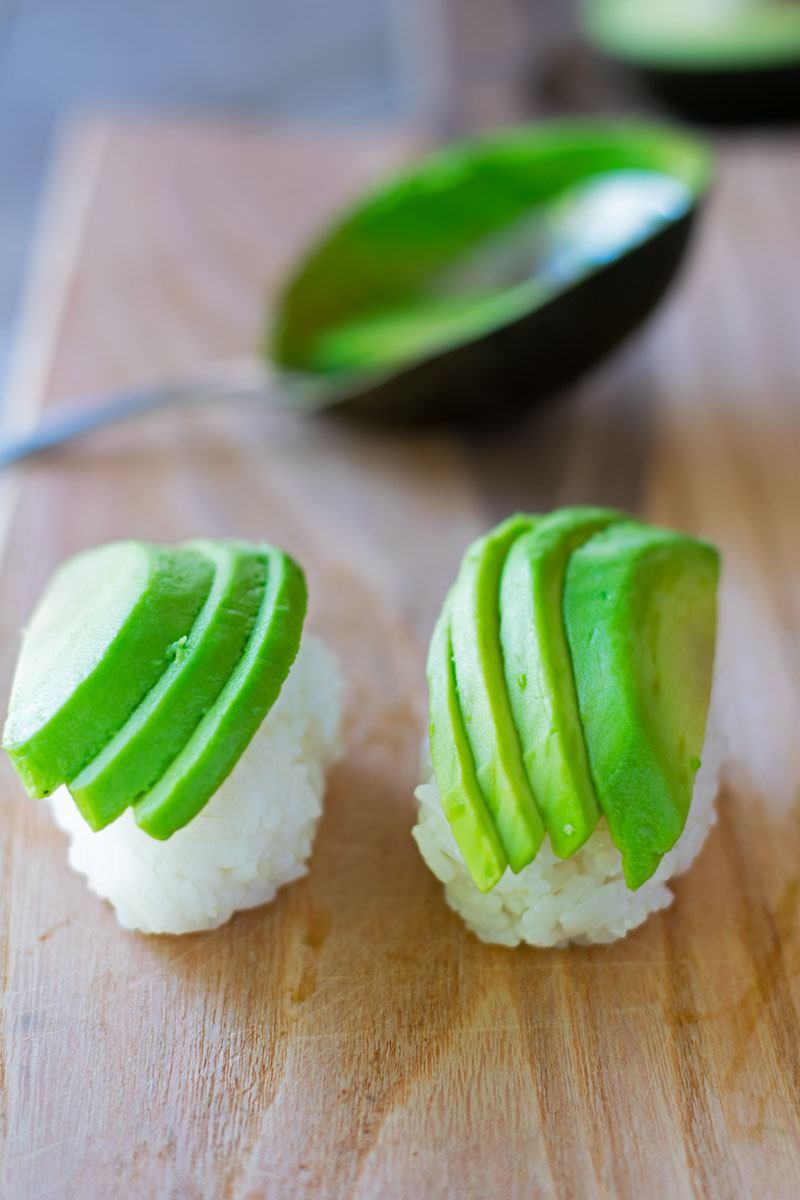
Avocado sushi ingredients
One whole avocado is enough to make two servings (= 4 pieces of sushi).
? whole avocado
? sushi rice (uncooked)
? rice vinegar
? Kosher salt
? sugar
? grass-fed butter
? organic lemon
? beets
? mayonnaise (or vegan alternative)
? soy sauce (or gluten-free alternative)
How to make avocado sushi
Scroll all the way down to see the full recipe.
- First, gather all cooking tools and ingredients.
- Wash, soak, and cook rice about 1.5 hours ahead of time.
- Using clean kitchen scissors or a sharp knife and cutting board, cut one sheet of dried nori seaweed into long, thin strips.
- Mix rice with vinegar seasoning mix (purchased or homemade).
- Peel and chop beets into small chunks and mix with mayonnaise- set aside.
- Half avocado with a sharp knife and slice into thin strips.
- Wet your hands. Then, form oblong balls of sushi rice on a plate.
- Carefully place slices of avocado on top of each ball of sushi rice. Gently press down until strips of avocado stick to the top of the rice ball.
- Add about ½ teaspoon of butter on top of the avocado.
- Slowly melt butter with a cooking torch.
- Squeeze lemon juice and sprinkle lemon zest on top of each piece of sushi.
- Lightly toast the lemon zest with cooking torch.
- Gently wrap each piece of sushi with a strip of nori seaweed.
- Top with beet/mayonnaise mixture and serve warm.
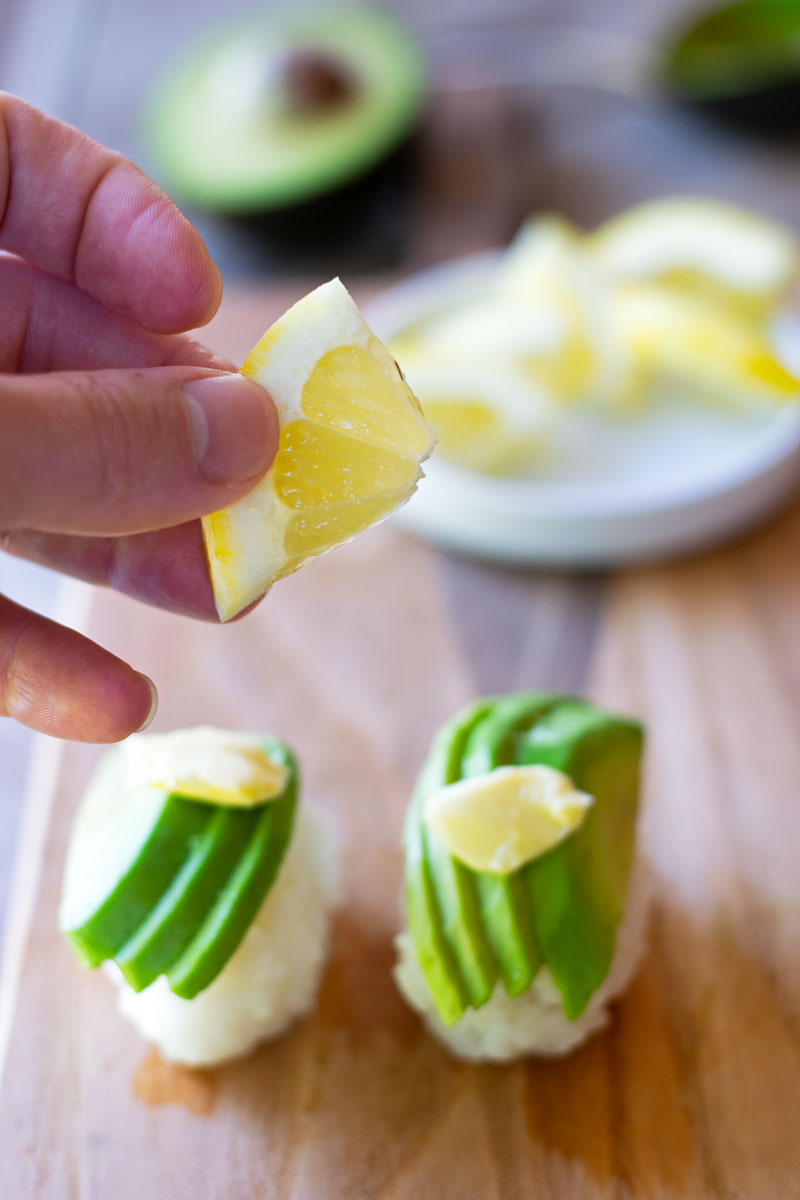
When is an avocado ripe?
I understand your agony when you cut open an avocado you just bought to reveal the dark brown mush inside.
These two quick checks will help you pick ripe and ready-to-eat avocados!
1) Thumb indent method
For this recipe, I recommend using avocado that are on the firmer side with no brown imperfections that you'll need to cut out.
To test the perfect ripeness, pick up the avocado and hold gently in the palm of your hand.
Gently press your thumb into the peel. If you're able to make a small indent (¼ cm) and the peel immediately bounces back up, that indicates the perfect ripeness.
If the indent remains and the avocado feels soft or mushy, that's over-ripe.
2) The secret method
This is my top secret method of ensuring your avocado is good!
Gently peel off and peek under the stem, you know that little black-colored stub.
It's not necessary to pull the stub off entirely. Your supermarket might not appreciate that.
You're looking for a light green or white-ish color.
If underneath the stem is brownish or black, that's a reliable sign that the inside of the avoacado has already gone bad.
When is avocado season?
Even in Tokyo, we can buy avocado year-round that was shipped from California, Mexico, or even South America.
In the U.S. avocados are available year-round but the seasons vary depending on where they are grown.
California Avocados are in season from spring through summer/early fall, according to the official California Avocado website. (I highly recommend using California Avocados for this recipe if available.)
In Mexico, the season essentially lasts all year long.
Peru grows avocados from April to September.
Chile's season runs from September to June.
I find that my local organic supermarket in Tokyo carries California avocados during the summer and then switches over to selling Mexican avocados the rest of the year.
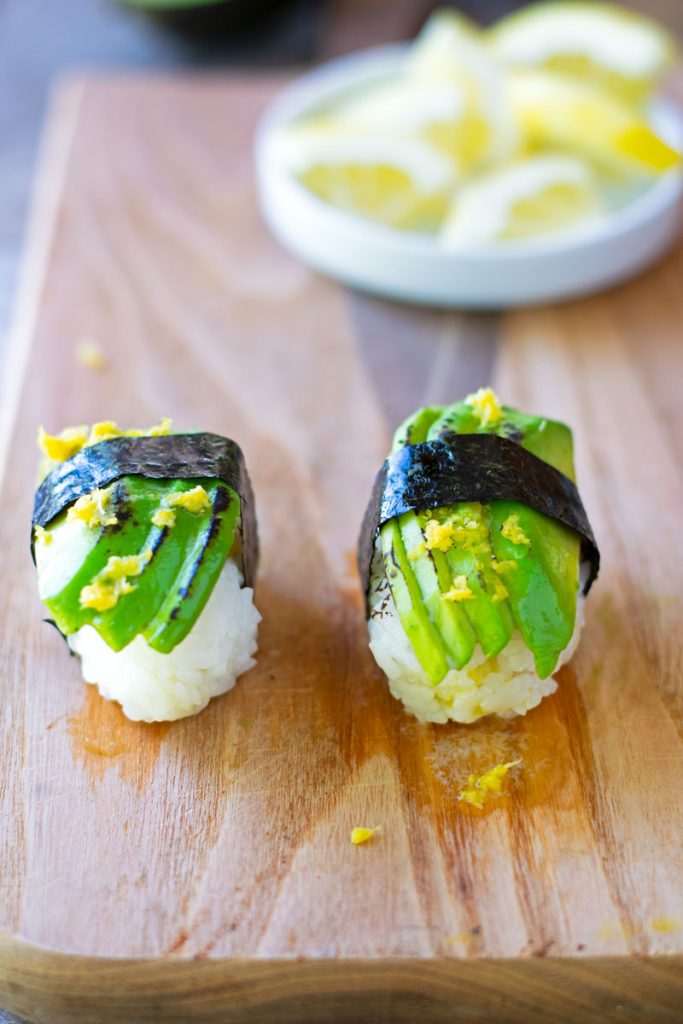
How to cut avocado for sushi
I learned to cut avocados with this technique in Mexico. I'll teach you step-by-step so you can get those thin, perfectly sliced pieces of avocado to top your sushi rice.
? Step 1 : Cut avocado in half - Using the sharpest knife you own (unless you are a ninja) and cutting board, carefully slice the avocado the long way, from stem to the bottom. With your fingers out of the path of the blade, slowly rotate the avocado until the halves of avocado spit in two.
Tip: Leave the pit inside the one half until later. This will prevent the avocado half from going brown.
? Step 2 : Cut half avocado into strips (inside the peel!) - Place the one half avocado without pit face up, peel facing down. Start with the knife tip at the stem. With your fingers safely out of the way, cut one long, vertical line from the stem to the bottom of the half of avocado. With the knife at about a 45 degree angle, press down slowly and gently. Make sure to cut all the way through the avocado flesh so that the point of the blade scratches against the inside of the avocado peel.
? Step 3 - Repeat cutting vertical lines about ¼ inches apart until the entire avocado half is sliced. I start in the middle and work my way to the left and right.
Safety tip: Always keep your fingers out of the path of the knife blade.
How to remove avocado from peel
? Step 1 - Use a metal spoon (approximately tablespoon size), preferable with a sharper edges and tip. Start at the base of the avocado, with the stem facing your body on the cutting board. Holding the avocado half down with one hand, firmly press the spoon tip down between the inside of the avocado peel and the flesh. Gently and slowly move the spoon's edge from side to side to separate the avocado flesh from the inside of the peel. Just like scooping ice cream, remove the entire half of avocado from the peel in one slow scooping motion towards the stem.
Tip: Until you've had practice, do this step slowly. The trick is to always keep pressure on the inside of the avocado peel with the tip of your spoon.
? Step 2 - Use your fingers if necessary to keep the slices of avocado together and not falling out of your spoon. Turn the spoon upside-down and place the strips of avocado face down (the flat side with the pit opening). Keep all the slices intact until you are ready to make your avocado sushi.
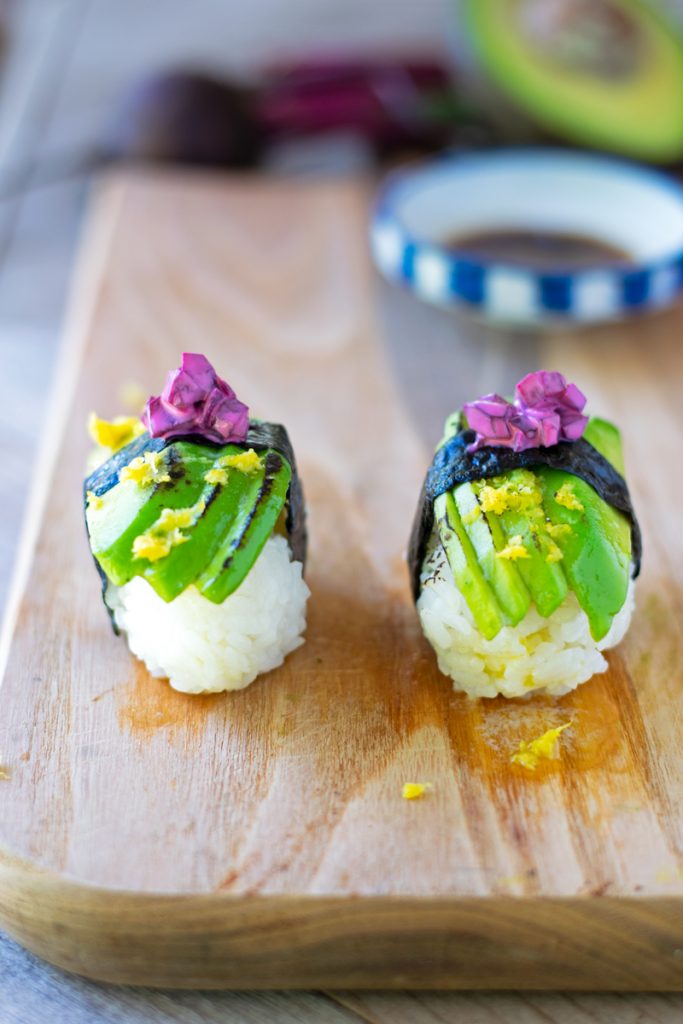
What's the best sushi rice to use?
Now that I am making avocado sushi this summer in the U.S., I wish I had brought a bag of rice home with me from Japan. The quality is unsurpassably good! Fortunately, there are still some good California-grown rice that worked fine.
Budget-friendly Japanese rice
Nishiki - this medium grain Californian rice is widely available at supermarkets in the U.S. ( I used it while developing this recipe. The taste and texture was pretty good!)
Kokuho Rose - 100% California grown medium grain rice (gluten and wheat free)
Premium brands of Japanese rice
Tamaki Gold - California koshihikari short grain rice (I haven't tried this brand but my Japanese blogger friends recommend this one.)
Tamanishiki - "Super premium" short grain California rice. Widely used by prestigious Japanese restaurants. ( I ordered a 5 lb. bag on Amazon. This is my top recommendation.)
How to make sushi rice
The trickiest part of making this avocado sushi recipe is the rice. Here are three recipes for sushi rice that should help.
Just One Cookbook's How to Make Sushi Rice (Video)
Chopstick Chronicle's How to Make Perfect Sushi Rice (with trouble-shooting tips)
Pickled Plum's How to Make Sushi Rice (with rice cooker)
What's the best nori seaweed to use?
Since such a small amount of nori is used for this recipe, I wouldn't worry too much about choosing the best brand.
Here are three brands that are available online:
Yamamotoyama Ariake Premium Japanese Nori Roasted Seaweed (10 sheets)
Daechun(Choi's1) Roasted Seaweed organic, 50 sheets, harvested in South Korea (best seller on Amazon)
GimMe sushi Nori organic, 50 sheets, harvested in South Korea.
To learn more, you can check out my "Essential Guide to Nori Seaweed".
If you don’t have any nori, you can still make avocado sushi without it. It’s just a nice, small added touch.
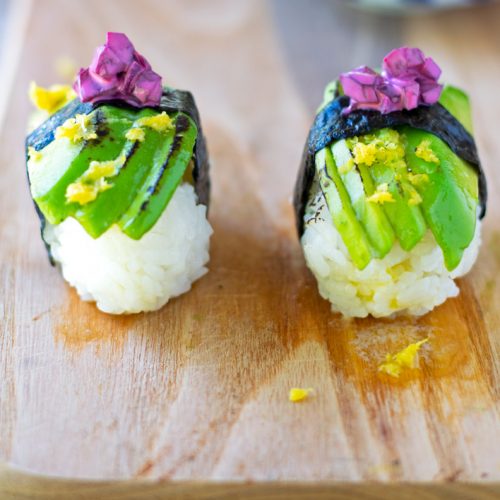
Avocado Sushi
Ingredients
Sushi Rice
- .6 rice cooker cups Japanese sushi rice short grain
- 1 cup water
- ¾ tablespoon rice vinegar
- ½ tablespoon sugar
- ⅓ teaspoon kosher salt
- 1 small piece kombu (2 inch x 2 inch) optional
Nigiri toppings
- 1 ripe avocado
- ½ organic lemon
- 1 teaspoon grass-fed butter
- 1 sheet nori seaweed
- 1 red beet
- ½ teaspoon mayonnaise or vegan mayo
Instructions
Sushi Rice
- Please see one of the three sushi rice recipes I listed directly above this recipe if it's your first time making sushi rice.
- Keep sushi rice covered with a damp towel or paper towel until you are ready to use it.
Nigiri (How to Make Sushi)
Nori Seaweed
- Using clean kitchen scissors or a sharp knife and cutting board, cut one sheet of nori seaweed into strips approximately ½ inch wide.
- Seal strips in an airtight Ziplock bag or airtight container and keep in the refrigerator until needed.
Beets Topping
- Wash and peel beet with a vegetable peeler.
- Mince or dice beets into small, uniform cubes.
- Place diced beets in a small bowl and add mayonnaise. Mix together with a spoon until beets are evenly coated and the mayonnaise turns pink in color.
- Cover beets/mayo topping and keep in the refrigerator.
Avocado
- Using the sharpest knife you own and cutting board, carefully slice the avocado the long way, from stem to the bottom. With your fingers out of the path of the blade, gently rotate the avocado until the halves of avocado spit in two. Tip: Leave the pit inside the one half until later. This will prevent the avocado half from going brown.
- Start with the knife tip at the stem. With your fingers safely out of the way, cut one long, vertical line from the stem to the bottom of the half of avocado. With the knife at about a 45 degree angle, press down slowly and gently. Make sure to cut all the way through the avocado flesh so that the point of the blade brushes against the inside of the avocado peel.
- Repeat cutting vertical lines about ¼ inches apart until the entire avocado half is sliced. Safety tip: Always keep your fingers out of the path of the knife blade.
- Use a metal soup spoon (approximately tablespoon size), preferable with a sharper edges and tip. Start at the base of the avocado, with the stem facing your body on the cutting board. Holding the avocado half down with one hand, firmly press the spoon tip down between the inside of the avocado peel and the flesh. Gently and slowly move the spoon's edge from side to side to separate the flesh from the inside of the peel. Just like scooping ice cream, remove the entire half of avocado from the peel in one slow scooping motion towards the stem. Tip: Until you've had practice, do this step slowly. The trick is to always keep pressure on the inside of the avocado peel with the tip of your spoon.
- Use your fingers if necessary to keep the slices of avocado together and not falling out of your spoon. Turn the spoon upside-down and place the avocado half face down (the flat side with the pit opening). Keep all the slices intact until you are ready to make your avocado sushi.
Shaping Rice Balls
- Wet both of your hands. Scoop up a small ball of rice (about 3 tablespoons) with your right hand. Squeeze it until it sticks together into an oblong ball. Then transfer it to your left hand. While tightly cupping your left hand, press down on top of the rice with two fingers.
- Pick up the ball of rice with your fingers, rotate it 180 degrees, and repeat the steps: cupping and pressing with two fingers. Flip it over upside-down and repeat again. Rotate it 180 degrees and repeat once more.Continue if necessary, until you have a neat oblong shaped rice ball. (See photo above.)
- Using your fingers, place oblong balls of rice on serving plates.
Adding toppings on top of rice balls
- Then, still using your fingers, place three strips of avocado on top of each ball of sushi rice.
- Gently press down on the avocado strips with the palm of your hand, firmly enough so the avocado sticks to the top of the balls of rice.
- With a spoon or knife, put a small slab of grass-fed butter on the top center of the avocado. (Skip this step to make this recipe vegan.)
- On low heat, melt the butter and toast the top layer of avocado with a culinary butane torch. Move the flame back and forth until the edges of the avocado are slightly charred.
- Cut small slices of lemon. Squeeze the juice of one lemon slice on one or two pieces of avocado sushi.
- With a zester or fine grater, zest the lemon peel and sprinkle evenly on top of the avocado slices.
- Using the cooking torch on low heat, gently torch the lemon peel zest, just enough that it smokes a little and you see very fine black lines of charring. This will give the avocado sushi a very subtle smokey taste.
- Lay a strip of nori seaweed across the avocado sushi, perpendicular to make a 't'. Wrap each piece of avocado sushi with a strip of nori seaweed. Pinch or cut off excess to make the strips of nori the right length to wrap underneath. Very gently pick up the rice ball and tuck the ends below. With your finger, press nori against the rice ball so it sticks tightly.
- Using a spoon, carefully garnish the top of each piece of sushi with the beets/mayonnaise mix. Place it right in the middle, on top of the strip of nori seaweed.
- If possible, serve with the sushi rice still warm. Be patient with yourself because this takes some practice and know how.
Notes
What to serve with avocado sushi?
In Japan, sushi is always accompanied with gari (pickled ginger). Gari can be store bought. If you have time, homemade gari is even better.
Avocado sushi would also go well with these recipes:
Seaweed Wraps (can be made vegetarian)
Tamagoyaki (Japanese Omelette) (can be made vegetarian)
Green Tea Shots (vegan)
How to store sushi rice
Rice gets dried out if you keep it in the refrigerator. My Japanese mom in Gunma always wraps leftover rice with plastic wrap and puts in the freezer. A more environmentally-friendly way is to put your leftover rice in an airtight storage container and put it in your freezer.
My Japanese mom defrosts rice in the microwave. If you avoid microwaving, you can defrost it overnight in the fridge and possibly warm it up to room temperature on the stove or in the oven.


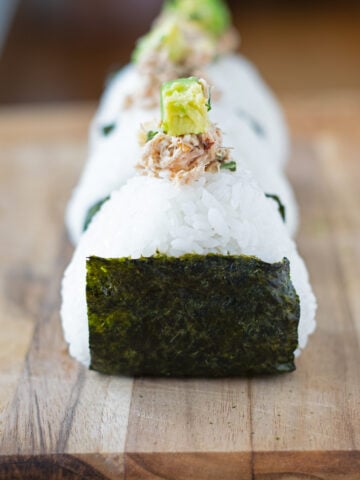


Vanessa says
It is all fine,as the Italian might consider the Japanese naporitan also "a bizarre version of spaghetti" . In Brazil they use cream cheese in temakis for example..In the UK the chiken tikka masala never really came from India,but created in the British land! Every culture tends to have at least one "Frankstein recipe" taken from another culture. No taboo here 🙂 いただきます 🥢 Thank you for the lovely blog! ありがとございます
Matt says
Vanessa, thank you so much for taking the time to leave a comment and checking out my blog. If you have any other Japanese recipes you're interested in, I'd love to hear from you! I really appreciate your kindness.